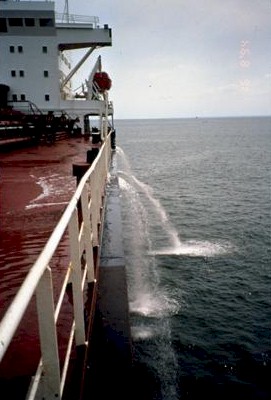 All vessels calling to Canada are obligated to exchange ballast at deep sea if they require discharging ballast in Canadian Waters. A vessel must exchange ballast water during the course of its voyage, at a distance of more than 200 nautical miles from any shoreline where the water depth is at least 2,000 meters. The salinity must be more than 30 ppt (Parts per thousand), in order for discharge to be allowed.
All vessels calling to Canada are obligated to exchange ballast at deep sea if they require discharging ballast in Canadian Waters. A vessel must exchange ballast water during the course of its voyage, at a distance of more than 200 nautical miles from any shoreline where the water depth is at least 2,000 meters. The salinity must be more than 30 ppt (Parts per thousand), in order for discharge to be allowed.
Exception — Laurentian Channel
If, in respect of a voyage to a port, offshore terminal or anchorage area in the Great Lakes Basin, St. Lawrence River or Gulf of St. Lawrence, the requirements of subsection (2) cannot be met because doing so would compromise the stability or safety of the vessel or the safety of persons on board the vessel, the Minister must be notified as soon as possible. After notice is provided, an exchange may be conducted, beginning on December 1 and ending on May 1, in an area in the Laurentian Channel east of 63° west longitude where the water depth is at least 300 m.
Alternative exchange areas:
If the requirements cannot be met because doing so is infeasible or would compromise the stability or safety of the vessel or the safety of persons on board the vessel, an exchange may be conducted in the following areas in waters under Canadian jurisdiction:
1. In respect of a voyage to a port, offshore terminal or anchorage area on the east coast of Canada, an area south of 43°30′ north latitude where the water depth is at least 1 000 m
2. In respect of a voyage to a port, offshore terminal or anchorage area on the west coast of Canada, an area at least 50 nautical miles west of Vancouver Island and the Queen Charlotte Islands and at least 50 nautical miles west of a line extending from Cape Scott to Cape St. James where the water depth is at least 500 m, with the exception of waters within 50 nautical miles of the Bowie Seamount (53°18′ north latitude and 135°40′ west longitude);
3. In respect of a voyage to a port, offshore terminal or anchorage area in Hudson Bay, an area in Hudson Strait east of 70° west longitude where the water depth is at least 300 m; and
4. In respect of a voyage to a port, offshore terminal or anchorage area in the High Arctic, an area in Lancaster Sound east of 80° west longitude where the water depth is at least 300 m.
Exception — west coast
If, in respect of a voyage to a port, offshore terminal or anchorage area on the west coast of Canada, cannot be met because doing so is infeasible or would compromise the stability or safety of the vessel or the safety of persons on board the vessel, an exchange may be conducted in an area at least 45 nautical miles west of Vancouver Island and the Queen Charlotte Islands and at least 45 nautical miles west of a line extending from Cape Scott to Cape St. James where the water depth is at least 500 m, with the exception of waters within 50 nautical miles of the Bowie Seamount (53°18′ north latitude and 135°40′ west longitude).
